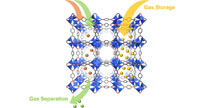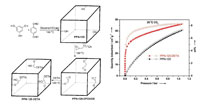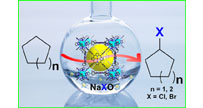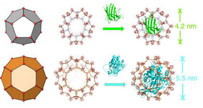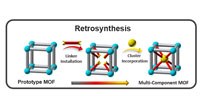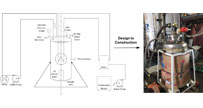Gas Storage
One of the key challenges in the storage of gaseous materials is their relatively low density when stored as a bulk gas. When looking at using gases for commodity energy generation this lack of space can become a large issue. High surface area porous materials represent a valuable technique to improve gas storage while avoiding cryogenic temperatures or high pressures. The Zhou group is interested in tuning the capacity of these materials through the design of new pore architectures, improving surface interactions through chemical effects, and through incorporating these materials in novel devices or processes. In particular, we are interested in probing the fundamental interactions that occur between gas molecules and their host framework, using our fundamental knowledge to engage in a data-driven, smart design approach for new porous materials.
Gas Separation
As part of our keen interest in reducing the environmental impact of modern industrial process we have been at the forefront of research into the separation of harmful gases such as CO2 from the atmosphere. In particular we have been interested in producing low cost, high affinity capture systems based on inexpensive organic polymers. Our series of porous polymer network (PPN) based sorbents take advantage of the chemical affinity acidic gases have towards basic moieties. By utilizing organic backbones we can easily and cheaply incorporate basic functionalities while still keeping costs below that of other sorbents. The physically and chemically robust organic backbones also allow for these materials to be utilized under conditions that would be disadvantageous for other sorbents, such as MOFs.
Porous material represent a fascinating new area for advanced catalytic processes. In highly crystalline porous materials such as MOFs catalytic sites can we well isolated and installed in controlled environments. This can improve the catalysts overall lifetime by preventing deactivation pathways, which typically occur because of the introduction of poison species, or by catalyst agglomeration. In addition, the heterogenous nature of MOFs allows them to be easily recycled, which can greatly improve the lifecycle of a catalyst, reducing the cost and energy consumption associated with catalyst production. By utilizing the physisorptive properties of MOFs we can also alter reactions kinetics, which allows for a much greater control over product ratios compared to homogeneous systems, allowing for processes such as reactive separation to occur.
Biological Integration
The Biological Subgroup in Zhou group has grown rapidly in recent years and became a significant focus of the Zhou Group. The aim of this subgroup is diversifying the applications of MOFs in the biomedical field. We are interested in the use of MOFs for enzyme immobilization, which utilizes the high structural stability of the framework to improve the catalysis lifetime of enzymes outside of typical cellular environment. The MOFs provide a protective layer to the enzymes, allowing for improved recyclability in harsh conditions. We are also interested in the development of Nano-Porous Cages (NCP) for applications in targeted drug delivery for cancer therapy. These nanocages combine the attractive feature of both inorganic and organic materials. They are of the appropriate size and have tunable surface charges, which allows them to be tailored to pass through the membrane of cancer cells and making them a promising platform for in targeted and efficient drug delivery.
Developing a Synthetic Toolkit for Porous Materials
Despite numerous advantages, the applications of MOFs are ultimately limited by their stability under harsh conditions. Therefore, we have been focusing on the development a variety of stable MOFs platforms. The conventional “one-pot” synthetic method of MOFs lacks control over the reaction pathways and the products, which essentially limits the construction of robust and functionalized MOFs. By judicious kinetic and thermodynamic control, we have developed multiple synthetic strategies, which have led to the “total synthesis” approach, through which a target MOF can be retro-synthetically designed and synthesized. These synthetic strategies have been developed to stabilize and functionalize MOFs by “layer-on” molecular elaborations to preformed coordination assemblies, which together form a synthetic toolbox. This synthetic toolbox is allowing our group to design MOFs for the specific applications listed above.
Large Scale Application of Porous Materials
The company framergy was founded in early 2011 by J.M.Ornstein to commercialize the groundbreaking innovations in Dr. Hong-Cai Zhou's laboratory at Texas A&M University. Through this project’s high-alkane enhanced, Metal-Organic Framework (MOF) based storage technology and its laboratory testing, framergy showed the feasibility of a flexible, transportable, low-cost infrastructure to abate flaring and venting.

